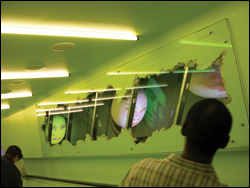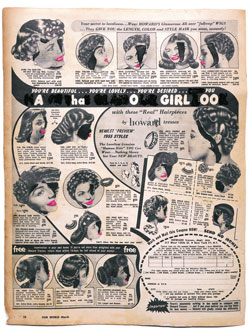There’s a German expression, “to lose the red thread,” which means losing one’s train of thought. In its current show, Howard House has found that thread. Julie Ryan, a curator, artist, and writer, organized “The Red Thread: Glimpses of International Art in Vienna,” a two-part exhibition featuring artists working and living at least part time in Austria’s capital. Part one of the show is at Howard House; the second half is currently on display at the Educational Alliance Gallery in New York.
Vienna has become a magnet for artists from all over the world, including the 15 individuals and artist teams that are part of “The Red Thread.” Excellent artist residency programs, a low cost of living, and living art legends like Franz West are just a few of the reasons.
An artistic collaboration with West took Ryan from New York to Vienna. She knows Billy Howard, who runs Howard House, from the University of Washington’s School of Art. And so the figurative string was strung, connecting the East and West coasts with artists from across the Atlantic.
This is a complex exhibit whose emotional tenor ranges from cool detachment to an almost urgent earnestness. Unlike the formal, richly historical city that connects them, artists in “The Red Thread” favor informal approaches to art making, use disposable materials, and comment on contemporary cultural themes.
West has two formidable sculptures at Howard House. The front room of the gallery features Mercury (pictured), an ungainly behemoth composed of a patchwork of fused metal. Like many of West’s sculptures, Mercury is meant as an interactive structure that viewers can climb and sit on. Bulbous nodules extend from its horizontal base, and the seams of the dark, maroon metal look like scars, rendering it at once vaguely obscene and absurdly playful.
Sisyphus, the other West sculpture on display, is a bulky conglomeration of bits and wads of paper propped in the back room on a makeshift plinth (base block). Though it’s as solid as the boulder its title references, its surface is like oozing skin: partly coated with poured murky paint, partly cloaked in small clumps of newspaper detritus.
The strenuous act of making each of these sculptures is eminently apparent and central to the content of West’s work. West considers creation a symbolic act. As you might expect, he likens the artistic process to the plight of Sisyphus, the mythological figure who eternally rolled a boulder up a hill only to have it come crashing back down. For West, art involves a Sisyphean search for what he calls the “absolute” through the seemingly senseless accumulation of materials. However, unlike Sisyphus’ futile quest, West’s process can lead to epiphany, making sense of the senseless.
Similarly, Viennese artist Elisabeth Penker’s art serves a facilitative function, easing the act of translation. Penker uses Haida iconography in her multimedia work because it provides potent visual symbols that communicate single words and whole sentences simultaneously. Her prints at Howard House feature fragments of icons floating in the paper’s white space. They are spare, visually arresting characters that employ an iconographic language as encoded symbols of communication.
Also featured in “The Red Thread” is Donald Baechler, an internationally known American painter who spends extended periods of time in Vienna. Baechler equalizes his imagery by painting it all in the same style. For him, the source of an image doesn’t matter, whether it’s a drawing by Picasso or graffiti on a bathroom wall. What matters is the newfound context his paintings provide.
Victory by Default is part of Baechler’s “Skull” series. In this piece, a painted skull gapes from the dirty yet sensuous confines of a large canvas. Terry cloth and wrinkled rags provide literal texture and reference the world outside the painting’s boundaries. Splatterings of color around the skull, like the self-conscious marks of Jasper Johns, seem to express the language of painting—hue and gestural strokes—in a factual rather than illusional manner.
Another American painter, Lisa Ruyter, lives half-time in Vienna, where she runs an influential gallery. She works from photographs projected onto large-scale canvases, tracing the contours of the projected imagery with consistent black outlines. In a way that seems arbitrary, she paints the shapes formed by her contour lines in flat, designer colors. Man of Means, based on a photo of fashion photographers, looks like a scrambled color-by-numbers painting.
I can’t do justice to the unusually rich assortment of conceptual art in “The Red Thread.” You’ll just have to see it for yourself: Thomas Bauman’s thrashing triangular foil blanket, Walter Seidl’s slide show of staged snapshots, Markus Schinwald’s photograph of a contortionist, and the other thoughtful works connected by “The Red Thread.”
“The Red Thread: Glimpses of International Art in Vienna” runs through April 30 at Howard House, 604 Second Ave., 206- 256-6399; 10:30 a.m.–5 p.m. Tues.–Sat. Free.






